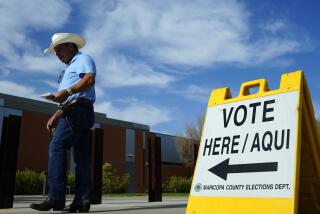U.S. Court Jury Selection Process Upheld : Ruling: Appellate decision says the system used in Santa Ana does not exclude blacks.
- Share via
SANTA ANA — An appellate court Tuesday upheld the fairness of a new jury selection process for Santa Ana federal court which challengers had contended unconstitutionally excludes blacks.
“There was no evidence to support an argument that (the system) resulted in the exclusion of distinctive minorities from participation . . .” Judge Linda H. McLaughlin of the 9th Circuit U.S. Court of Appeals wrote.
The challenge had arisen from a 1993 case in which Todd Eugene Cannady, a black man charged with bank robbery, was convicted by a jury consisting almost entirely of whites. In appealing Cannady’s conviction, lawyers from the U.S. public defender’s office had argued that the nearly homogenous jury resulted from a new jury selection process initiated the same year that significantly reduced the geographic areas from which jury pools are drawn.
In Santa Ana, the change meant that jurors would now be selected only from Orange, Riverside and San Bernardino counties, which have proportionately fewer blacks than Los Angeles County from which some jurors previously had come. By excluding the more diverse area, the lawyers argued, the court had deprived Cannady of his constitutional right to a jury of his peers.
Later, two other defendants were added to the appeal on the same grounds: a Latino man convicted of illegally possessing a firearm and another black man convicted of bank robbery.
McLaughlin wrote in the decision that there was no evidence of the “statistical underrepresentation of distinctive groups” or the presence of “any discriminatory intent” in the jury selection process.
Monica Knox, a deputy federal public defender involved in the case, expressed disappointment at its outcome.
“What it means is that defendants tried in the Santa Ana courthouse will not have the opportunity to have people of color on their juries,” she said. “It renders the 6th Amendment right to a jury of your peers a non-reality. When they changed the process, they went from having jury pools that were diverse to those that are not.”
Prosecutors involved in the case disagreed.
“We are certainly pleased that the court agreed with our interpretation of the law,” said Miriam Krinksy, chief of the criminal appellate section of the U.S. attorney’s office in Los Angeles. “To have had the decision come out otherwise could have endangered the court’s ability to run itself efficiently.”
Jean Kawahara, chief of the U.S. attorney’s office in Santa Ana, concurred.
“We are very happy with this result,” she said. “There is a fair cross section of people represented in the jury panels of the Santa Ana courthouse. Defendants tried before juries drawn from these three counties are receiving fair and constitutional trials.”
More to Read
Sign up for Essential California
The most important California stories and recommendations in your inbox every morning.
You may occasionally receive promotional content from the Los Angeles Times.













